2011 Gimli, Manitoba, Canada
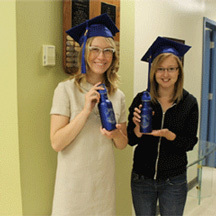
Holly Linklater and Callie McLaughlin from Gimli High School had a simple and very achievable goal to ban water bottles at their school:
Continue reading


2011 Gimli, Manitoba, Canada

Holly Linklater and Callie McLaughlin from Gimli High School had a simple and very achievable goal to ban water bottles at their school:
Continue reading
2011 Gimli, Manitoba, Canada
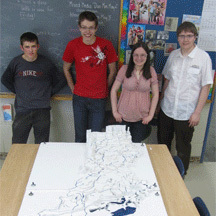
Gimli High School students Cole Wear, Christine Durocher and Erik Isliefson are concerned about the health and sustainability of Lake Winnipeg. They believe an understanding of watersheds is very important for stewardship and sustainability. As a class project, they constructed a model of the Lake Winnipeg Watershed. The project was created by Enviro Club members with support from a local Conservation District.
Continue reading
2011 Ponoka, Alberta, Canada
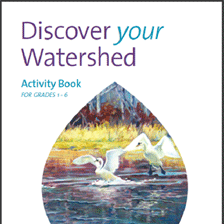
Caring for our Watersheds Contest Junior High Winners of 2010: Breanne, Jenna and Rachel wanted to tell a story of the importance of a healthy watershed. After researching the Battle River Watershed they decided that to have the greatest impact they should educate young people, which is exactly what they have done.
Continue reading
2011 Cromer, Manitoba, Canada
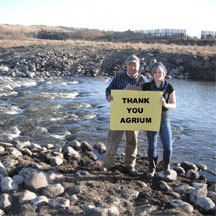
Growing up on a cattle farm, situated in a valley with a creek meandering through it, Kendra Elliott is familiar with the idea of livestock crossing through the water. With this, also comes the knowledge of the controversy surrounding the concept of farm animals being allowed in waterways. She proposed a structure called a Riffle crossing that is “positive for the environment, the farmers, and the animals”.
A student at Virden Collegiate, Kendra won first place at the Caring for Watersheds Competition. Her extensive knowledge on the topic and excellent presentation skills made the difference. Working with the West Souris River Conservation District, a plan was established to install a riffle crossing near Cromer, Manitoba. The Conservation District provided the work in kind and the materials and equipment needed was provided through a generous grant of $8000 made possible by Nutrien.
Kendra had a lot to say about her implementation process and experience:
“Actually having the riffle crossing installed almost seems surreal – most school assignments are just hypothetical, but this one came to fruition in a big way. I’m very thankful that Mr. Cochrane got us involved with the CFW program because none of this would have happened without that first step. Messages of how important it is to look after the environment surround us, but something like this makes it all that more real.
This riffle crossing will help improve the health of the Pipestone Creek, downstream to Oak Lake. This beautiful valley and creek is where I’ve grown up – it is home. Hopefully projects like these will help maintain that natural appeal for many future generations to come. Even the riffle crossing adds aesthetic value. The easiest way to explain it is that it’s a happy place – watching and listening as the water tumbles over the rocks.
It makes me proud to know that I was involved in making this happen.”

2011 Campbellford, Ontario, Canada
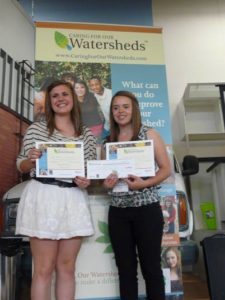
Kiersten Bertrand and Abbi Brown won first place in 2011 for their idea to plant native plants especially close to bodies of water. Through this project they wanted to involve local youth and schools, to raise awareness to the sensitivity of our watershed.
With funding from Nutrien the environmental club at Campbellford District High School, staff from Lower Trent Conservation, the Municipality of Trent Hills and community volunteers planted native shrubs and wildflowers along the Trent River shoreline at Hastings Village Marina.
The shoreline planting provides a colourful shoreline buffer, increase wildlife habitat and protect the shoreline from erosion.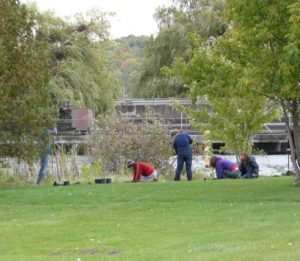
The Hastings Village Marina is a popular location for the local community and visitors to the Trent-Severn Waterway. Signage will be installed at the site to educate the public on the importance of natural shorelines.
2011 Ponoka, Alberta, Canada
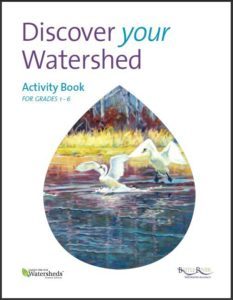
Caring for our Watersheds Contest Junior High Winners of 2010, Breanne, Jenna and Rachel wanted to tell a story of the importance of a healthy watershed. After researching the Battle River Watershed they decided that to have the greatest impact they should educate young people, which is exactly what they have done.
Breanne, Jenna and Rachel created the Discover your Watershed Activity Book for grades 1-6.
Inside the book are 12 colourful pages which include:
• Information on what is a watershed
• A Fishy Maze
• Water conservation tips
• Facts about Water
• A Watershed Crossword Puzzle
• A Water Saving Word Search
• A Coloring Page
• And space to draw your own watershed pictures!
The girls can now be found in the local elementary schools classrooms handing out their activity book to students. They are glad that their teacher Mrs. Perillat introduced them to the contest, and really enjoyed working together for a “greater cause”.
Thanks to Nutrien sponsorship, 500 copies of the book have been printed to educate students across the watershed.
2011 Ponoka, Alberta, Canada

Meghan Rain became interested in environmental issues when a highway was built through an untamed green space where she and the other neighborhood kids would play. She was sad not only because they lost their play area but also because there was a fox den destroyed. She has been determined to help the watershed ever since.
For her Caring for our Watersheds proposal, Meghan focused on the garbage and other pollution entering into the Battle River and other waterways and the impact on the animals.
“Fortunately the water we drink is cleaned and filtered but I can’t say the same for the animals. Animals of all shapes and sizes come to drink in our river; meanwhile pollutants and garbage float around inside of it.”
Meghan wrote a hip and catchy song called “Wake-Up” which educates people about the importance of keeping the waters clean. Meghan recorded the song and has shared it via email with friends, family and with over 100 people at the CFW Final competition.

2011 Sherwood Park, Alberta, Canada
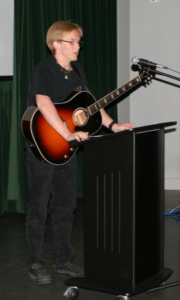
Scott Deshane was a finalist in the 2011 Caring for our Watersheds Contest. Avid singer/songwriter, Scott wanted to use his talents to promote people’s awareness of and care for the environment. Scott’s Watershed Song was written just for the CFW contest. This is what Scott had to say about it:
“Music has been proven to help not only raise awareness of certain topics, but also remind [people] to avoid making bad decisions. If a song is “stuck” in a person’s head, they will repeat the lyrics over and over to themselves, and this will subconsciously help them remember something. If a song were created with lyrics that could remind a person of the dangers of harming the environment and that song were to stay with the person, then they would avoid harming watersheds.”
“The lack of awareness of the environment is definitely the supreme issue” – Scott Deshane
Set to a series of photos of water, this song will inspire you to Care for your Watershed! (And you would never guess the artist is in High school!)
The video can be seen on the Battle River Watershed Alliance’s YouTube channel at: http://youtu.be/l-c1XFjLLF8
2011 Ponoka, Alberta, Canada
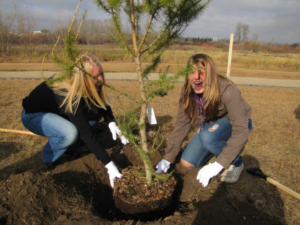
These smiling faces are those of Courtney and Rhyliegh from St. Augustine School in Ponoka. After doing research on the Battle River Watershed, they realized a very important factor in the water quality of their town and watershed was erosion. Their proposal was to plant trees along the Battle River to prevent shoreline erosion.
After winning 1st place in the Final Competition, they decided to turn their proposal into reality and implement a tree planting at a local park near their school in Ponoka.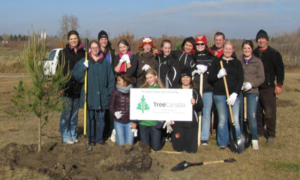
With the support of the Ponoka Home Hardware and Trees Canada the girls received 30 trees of various sizes. The town of Ponoka also supported the girls by having staff and equipment on hand to dig holes and water the planted trees. Fellow students from St. Augustine took the afternoon to come help plant.
Courtney and Rhyleigh were very happy to help their town and watershed have better quality water, animal habitat and air quality. They look forward to visiting that park for many years in the future
2011 Lethbridge, Alberta, Canada
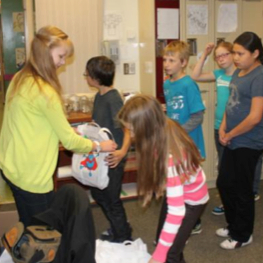
While most middle school students are worried about the present, Cassandra Schinkel is more concerned about the future. That’s why she took it upon herself to build and distribute Caring for Our Watershed Kits to help raise awareness and educate her peers about the importance of their watershed and of taking steps to care for their watershed.
Cassandra felt that it is very important to get children
involved at an early age so that they can be educated
about the environment and help preserve the world they
depend on for future generations. It’s important to raise awareness as many people take the watershed they live in, and the functions it provides, for granted. With her passion for raising awareness and of educating younger generations about the watershed they live in and what they can do, Cassandra hit 7 grade five classrooms in Lethbridge equipped with a 15 minute powerpoint presentation and 150 Caring for Your Watershed kits. Over 150 students heard her presentation and received a kit.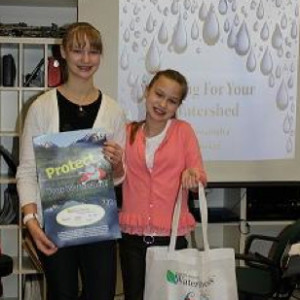
Each Caring for Your Watershed kit contained a watershed word search, bug jar, CFW seed bookmark, water warrior notepad, water warrior badge, water drop ball and a coloring sheet.
Cassandra wanted her project to be educational and fun at
the same time. What she didn’t expect to find out through
the implementation of her project was that she actually taught the teachers something about their watershed, as well as the children in the classrooms she visited.
Cassandra received corporate support for her project from Nutrien, Alberta Agriculture and Rural Development, St. Mary River Irrigation District and the Oldman Watershed Council.